 Cicchini Cicchini By Margo Kirchner Sentences in criminal cases in excess of plea-bargained terms should cease, says a Wisconsin attorney in an article written for the University of Illinois Law Review. Kenosha criminal defense lawyer Michael D. Cicchini labels as “deal jumping” the practice by which a judge accepts a defendant’s guilty plea yet hands down a sentence harsher than agreed upon by the defendant and prosecutor. Judges who so act are “deal jumpers,” which is the name of Cicchini’s article. According to Cicchini, deal jumping is fundamentally unfair to defendants and harmful to the criminal justice system, as more than 95% of cases are resolved by plea bargains. Yet the practice is permitted in several states, including Wisconsin, which is Cicchini’s focus. Cicchini advocates for state legislative reform to eliminate deal jumping by requiring judges to either (1) approve or reject sentence concessions at the same time they approve or reject plea agreements, or (2) allow defendants to withdraw their pleas if the judge plans to exceed the agreed-upon sentence. But if legislative change fails to occur, judges should act on their own to end deal jumping and defense attorneys should protect their clients from the practice. Cicchini provides defense lawyers with practical ideas to ensure that defendants receive the benefits of their plea bargains. To illustrate a deal jump, Cicchini describes a situation in which a defendant charged with multiple counts agrees to plead guilty to one count in exchange for the prosecutor’s dismissal of the other counts (a charge concession) and recommendation of a fine instead of probation or incarceration (a sentence concession). Deal jumping involves sentence concessions. In some states, says Cicchini, the judge would be required by law to either sentence this defendant to a fine or, if the judge plans to impose a penalty more severe, allow the defendant to withdraw the guilty plea. However, in other states, such as Wisconsin, regardless of the plea agreement the judge may impose whatever punishment the judge wishes up to the maximum allowed by law, and the defendant has no recourse to withdraw the guilty plea. Cicchini asserts that Wisconsin “freely permits the most egregious forms of deal jumping when it comes to the sentence.”
0 Comments
By Gretchen Schuldt
The number of people who were incarcerated in local jails for parole or probation violations dropped about 65% between Feb. 28 and Friday, April 3, according to the latest Department of Corrections statistics. Those released had been held under the short-term sanctions program for violations. There were 534 such jail inmates on Feb. 28; on Friday, there were 189, a decline of 345 or 64.6%. Although prisons and jails are excellent breeding grounds for the coronavirus, DOC is slow to move incarcerated people out of state prisons. The male prison population dropped 1.2% during the same time period, while the number of women held in all state correctional facilities dropped 3.4%. The number of prison inmates held under contract in county jails and the Milwaukee County House of Correction fell by 3.7%. The population of DOC's Division of Adult Institutions, which includes prisons, is about 23% over design capacity, according to DOC numbers. It is not clear how much of the decline in prison population is Gov. Tony Evers' March 22 announcement that the DOC would not accept inmate transfers from counties, and how much is due to additional releases. Advocates, including WJI, have urged Evers to release low-risk offenders to decrease the danger of coronavirus transmissions among prison staff and incarcerated people. The latest numbers are below. The source for all three charts is the Wisconsin Department of Corrections. By Gretchen Schuldt Advocates and medical experts around the country are urging prison officials to release low-risk incarcerated people from prison to stem the tide of the coronavirus, but prison populations in Wisconsin have declined just minimally, DOC figures show. Wisconsin has experienced some success in reducing the number of people on community supervision who are locked up for one reason or another. That number dropped 39% in about a month. The coronavirus crisis has been well-established in the public consciousness for more than a month. Gov. Tony Evers declared a public health emergency on March 13; he announced on March 22 that the State Department of Corrections would not accept inmate transfers from counties. News about the dangers of coronavirus in prisons and jails specifically began appearing months ago; in January, the focus was on prisons in other countries, such as China; by early March, corrections officials in the United States were well aware of the dangers to incarcerated populations here. Many court proceedings in the state have ground to a halt, meaning that fewer people are getting sentenced to prison, which should contribute to declines in prison populations. The charts below tell the story. The source for the charts is DOC inmate population counts. Men's prisons: No surprise that the maximum security male population has barely budged; after all, these are the men considered the greatest threats to public safety. But the declines in the populations of men considered to be of lesser risk also are minimal. Contract beds: A decline of a whopping 20 people, and the Milwaukee County House of Correction accounts for more than half of that total. Meanwhile, the DOC is not accepting inmates from jails. Other institutions: The number of people on community supervision who are in locked up has dropped significantly. The number of women serving prison sentences, though, has not dropped much, and the number in minimum security institutions has actually gone up by four.
|
Donate
Help WJI advocate for justice in Wisconsin
|
Copyright © 2024 Wisconsin Justice Initiative Inc.
The Wisconsin Justice Initiative Inc. does not endorse candidates for political office. The Wisconsin Justice Initiative Inc. is a 501(c)3 organization.
The Wisconsin Justice Initiative Inc. does not endorse candidates for political office. The Wisconsin Justice Initiative Inc. is a 501(c)3 organization.

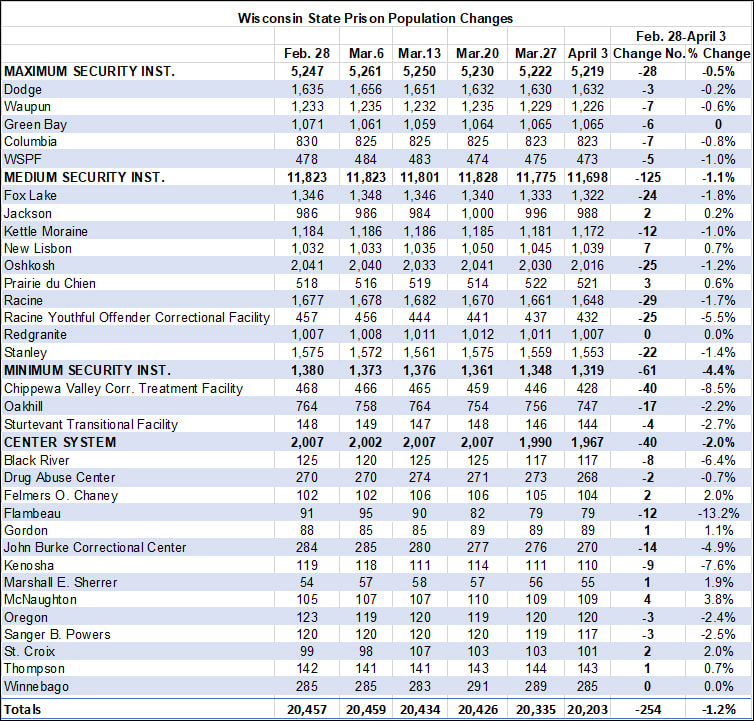
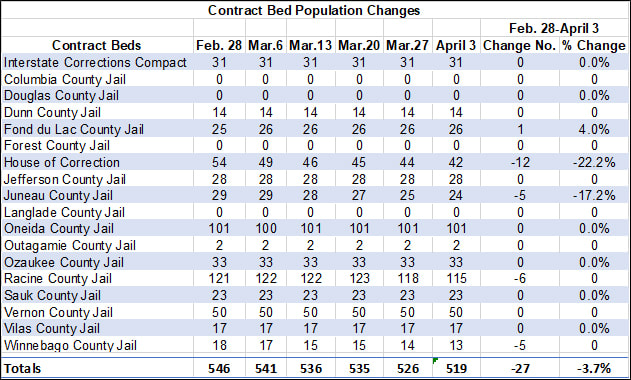
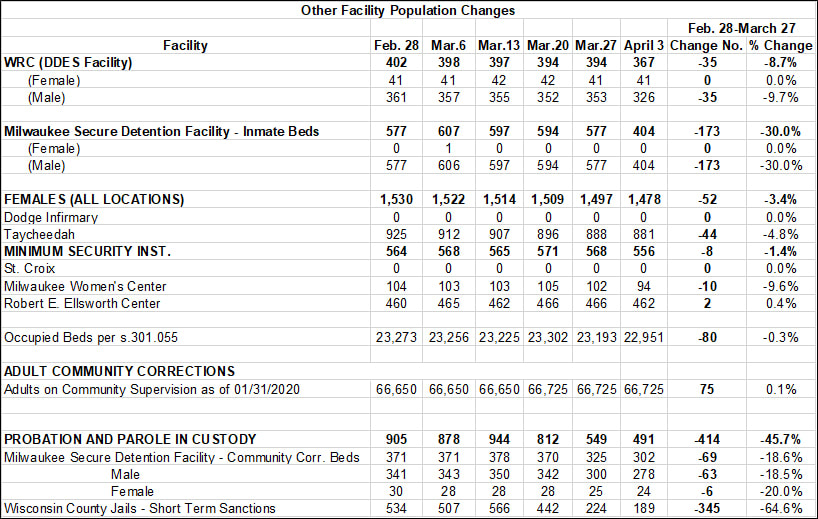
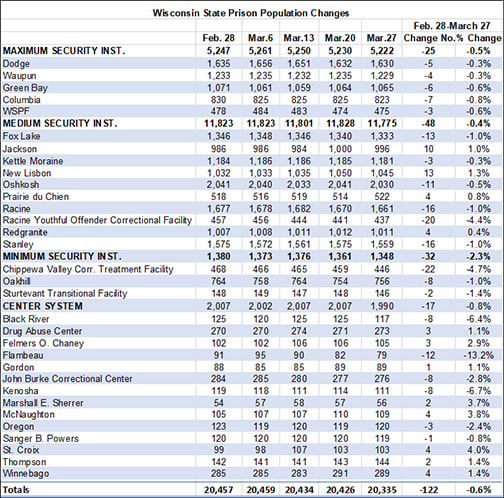
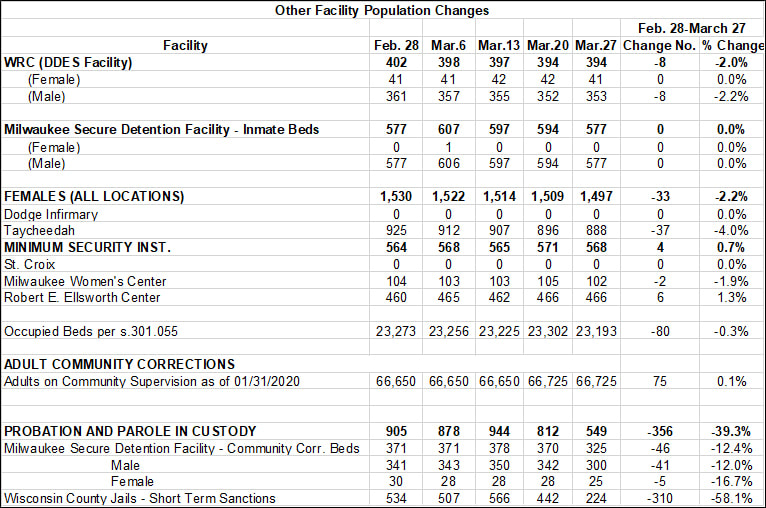
 RSS Feed
RSS Feed